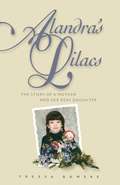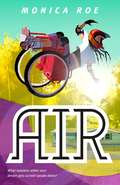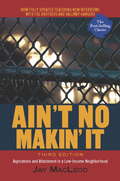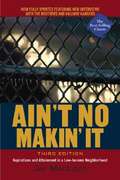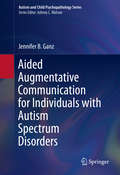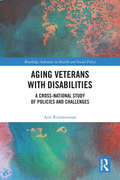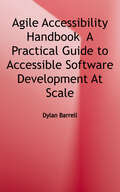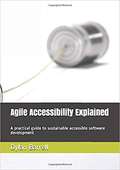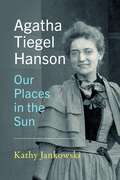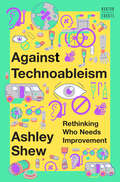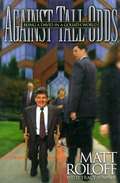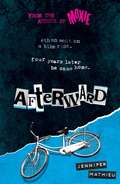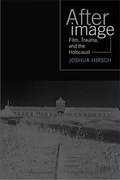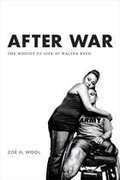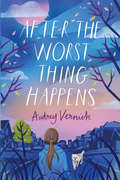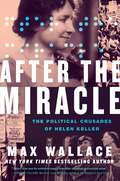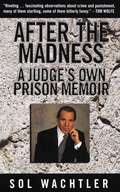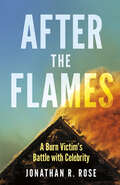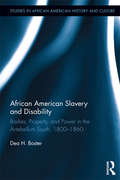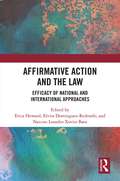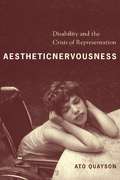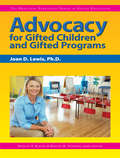- Table View
- List View
Alex: The Life of a Child
by Frank DefordFrank DeFord tells the heartbreaking, yet uplifting story of his daughter Alex's brief life. She died of cystic fibrosis at the age of eight.
Alandra's Lilacs: The Story of a Mother and Her Deaf Daughter
by Tressa BowersWhen, in 1968, 19-year-old Tressa Bowers took her baby daughter to an expert on deaf children, he pronounced that Alandra was "stone deaf," she most likely would never be able to talk, and she probably would not get much of an education because of her communication limitations. Tressa refused to accept this stark assessment of Alandra's prospects. Instead, she began the arduous process of starting her daughter's education. Economic need forced Tressa to move several times, and as a result, she and Alandra experienced a variety of learning environments: a pure oralist approach, which discouraged signing; Total Communication, in which the teachers spoke and signed simultaneously; a residential school for deaf children, where Signed English was employed; and a mainstream public school that relied upon interpreters. Changes at home added more demands, from Tressa's divorce to her remarriage, her long work hours, and the ongoing challenge of complete communication within their family. Through it all, Tressa and Alandra never lost sight of their love for each other, and their affection rippled through the entire family. Today, Tressa can triumphantly point to her confident, educated daughter and also speak with pride of her wonderful relationship with her deaf grandchildren. Alandra's Lilacs is a marvelous story about the resiliency and achievements of determined, loving people no matter what their circumstances might be.
Air: A Novel
by Monica RoeAn action-packed, empowering middle grade novel about a girl who has to speak up when her wheelchair motocross dreams get turned upside down.Twelve-year-old Emmie is working to raise money for a tricked-out wheelchair to get serious about WCMX, when a mishap on a poorly designed ramp at school throws her plans into a tailspin. Instead of replacing the ramp, her school provides her with a kind but unwelcome aide—and, seeing a golden media opportunity, launches a public fundraiser for her new wheels. Emmie loves her close-knit rural town, but she can’t shake the feeling that her goals—and her choices—suddenly aren’t hers anymore. With the help of her best friends, Emmie makes a plan to get her dreams off the ground—and show her community what she wants, what she has to give, and how ready she is to do it on her own terms.Air is a smart, energetic middle grade debut from Monica Roe about thinking big, working hard, and taking flight.
Ain't No Makin' It
by MacleodAuthor Jay MacLeod OCOs classic ethnographyOCoa defining work on the cycle of social reproduction and inequality as lived through the young men from the Clarendon Heights housing projectOConow includes a third section that continues the lives of the original Brothers and Hallway Hangers through new interviews and analysis.
Ain't No Makin' It: Aspirations and Attainment in a Low-income Neighborhood
by Jay MacleodThis classic text addresses one of the most important issues in modern social theory and policy: how social inequality is reproduced from one generation to the next.
Aided Augmentative Communication for Individuals with Autism Spectrum Disorders (Autism and Child Psychopathology Series)
by Jennifer B. GanzJust as autism is a continuum of disorders, it is associated with a broad range of neurodevelopmental, social, and communication deficits. For individuals with autism spectrum disorders (ASD), augmentative and alternative communication (AAC) has a major impact on their daily lives, often reducing the occurrence of challenging behaviors. Aided Augmentative Communication for Individuals with Autism Spectrum Disorders is a practical guide to the field, offering readers a solid grounding in ASD, related complex communication needs (CCN), and AAC, especially visual and computer-based technologies. Widely used interventions and tools in AAC are reviewed--not just how they work, but why they work--to aid practitioners in choosing those most suited to individual clients or students. Issues in evaluation for aided AAC and debates concerning its usability round out the coverage. Readers come away with a deeper understanding of the centrality of communication for clients with ASD and the many possibilities for intervention Key areas of coverage include: AAC and assessment of people with ASD and CCN. Interdisciplinary issues and collaboration in assessment and treatment. AAC intervention mediated by natural communication partners. Functional communication training with AAC. The controversy surrounding facilitated communication. Sign language versus AAC. Aided Augmentative Communication for Individuals with Autism Spectrum Disorders is an essential resource for clinicians/practitioners, researchers, and graduate students in such fields as child and school psychology, speech pathology, language education, developmental psychology, behavior therapy, and educational technology.
Aging Veterans with Disabilities: A Cross-National Study of Policies and Challenges
by Arie RimmermanThe number of older war veterans receiving disability benefits is steadily growing and is predicted to rise in the next decade. This book provides comprehensive knowledge about health and psychosocial concerns of veterans aging with disabilities and unmet needs and compares policy in three countries that have been involved in massive warfare in the 20th century––the United Kingdom (UK), the United States (US), and Israel. Using a cross-national comparative study of the policies, legislation and services provided by these three countries, which have significant numbers of aging disabled military veterans, this book provides evidence-based knowledge on the trajectories and attendant mental-health and psychosocial problems this sub-group faces when aging with a disability. It sheds light on the paradox in which most veterans with disabilities in the UK, USA and Israel are older, while the current legislation and budget target younger veterans with disabilities. The book reflects the current debate regarding the desired policy toward older veterans with disabilities in these countries and whether to provide them with proactive health services prior to retirement to prevent "accelerated aging". It also evaluates the dilemma of whether to serve aging veterans separately as a unique population or to provide them with the same services used by the general population. This book will be of interest to all academics and students working in disability studies, rehabilitation studies, gerontology, psychology, sociology, social work, social policy, and law more broadly.
Agile Accessibility Handbook: A Practical Guide to Accessible Software Development at Scale
by Dylan BarrellIt is estimated that one in five people has a disability; if you do the math, that's a huge, addressable market that is often overlooked. Digital Accessibility practitioners tap into this market by making digital documents-as well as web and mobile apps-accessible to everyone. However, many enterprises struggle to create, maintain, and scale their digital accessibility efforts. Agile Accessibility Handbook outlines the steps organizations can take to capture this market, avoid risk, maintain agility, and close the accessibility gap. Using the information provided within this handbook, accessibility subject matter experts, development team members, and executives in charge of setting priorities can together learn how to build successful accessibility experiences for everyone.
Agile Accessibility Explained: A Practical Guide to Sustainable Accessible Software Development
by Dylan A. BarrellYears of experience down in the trenches of accessibility remediation projects, driven by lawsuits related to the Americans with Disabilities Act (ADA) or laws like the Accessibility for Ontarians with Disabilities Act (AODA) in Canada have given Mr. Barrell experience as to the practices that work when implementing sustainable accessible software development. He has collected these together in a very practical guide on how to do agile accessible development that goes from the design and usability phase all the way through to deployment. On the way it deals with continuous integration and delivery, issue tracking, testing and coding as well as the organizational practices required to support the individual agile teams. A must read for anyone who takes accessibility seriously.
Agatha Tiegel Hanson: Our Places in the Sun
by Kathy JankowskiAgatha Tiegel Hanson (1873-1959) is regarded as a seminal figure in Deaf history for her writing, advocacy, and leadership, though her accomplishments merit recognition within the larger context of American history as well. Barely fifteen years old in 1888, Tiegel Hanson became one of the first women to attend the nation's only college for Deaf students, the National Deaf-Mute College, now known as Gallaudet University. Amid the hostility and skepticism of male students and faculty, she achieved exemplary academic success and was the first woman to earn a Bachelor of Arts degree from the college. Upon facing stringent campus restrictions and exclusion from male-only organizations and activities, Tiegel Hanson cofounded a society for female students. Her prerequisite graduation presentation, "The Intellect of Woman," was a powerful oratory that urged women to “move on till all barriers crumble and fall.” Throughout her life, Agatha Tiegel Hanson worked to advance the rights of Deaf people and women, and she was a passionate advocate of sign language rights. Her contributions include creative written works as well as influential treatises. She served in leadership positions at several Deaf organizations and, along with her husband, noted Deaf architect Olof Hanson, she played a vital role in the Deaf cultural life of the time. In Agatha Tiegel Hanson: Our Places in the Sun, author Kathy Jankowski presents a portrait of this trailblazer, and celebrates her impact on the Deaf community and beyond. This biography will be of interest to those already familiar with Tiegel Hanson’s legacy as well as to readers who are discovering her extraordinary life for the first time.
Against Technoableism: Rethinking Who Needs Improvement (A\norton Short Ser. #0)
by Ashley ShewA manifesto exploding what we think we know about disability, and arguing that disabled people are the real experts when it comes to technology and disability. When bioethicist and professor Ashley Shew became a self-described “hard-of-hearing chemobrained amputee with Crohn’s disease and tinnitus,” there was no returning to “normal.” Suddenly well-meaning people called her an “inspiration” while grocery shopping or viewed her as a needy recipient of technological wizardry. Most disabled people don’t want what the abled assume they want—nor are they generally asked. Almost everyone will experience disability at some point in their lives, yet the abled persistently frame disability as an individual’s problem rather than a social one. In a warm, feisty voice and vibrant prose, Shew shows how we can create better narratives and more accessible futures by drawing from the insights of the cross-disability community. To forge a more equitable world, Shew argues that we must eliminate “technoableism”—the harmful belief that technology is a “solution” for disability; that the disabled simply await being “fixed” by technological wizardry; that making society more accessible and equitable is somehow a lesser priority. This badly needed introduction to disability expertise considers mobility devices, medical infrastructure, neurodivergence, and the crucial relationship between disability and race. The future, Shew points out, is surely disabled—whether through changing climate, new diseases, or even through space travel. It’s time we looked closely at how we all think about disability technologies and learn to envision disabilities not as liabilities, but as skill sets enabling all of us to navigate a challenging world.
Against Tall Odds: Being a David in a Goliath World
by Matt Roloff Tracy SumnerRon and Peggy Roloff looked on in shock at the tiny baby before them. What will become of this boy with a stubby body and malformed limbs? As a dwarf, Mathew will have little to look forward to... except dozens of surgeries, years of painful rehabilitation, and daily encounters withthe pitying stairs of strangers. Matt Roloff wouldn't want life any other way.
Afterward
by Jennifer MathieuFrom the author of Moxie, soon to be a major Netflix production, directed by Amy Poehler.From the author of MOXIE, comes a moving story of self-discovery and the hope that comes with friendship.Ethan Jorgensen went on a bike ride four years ago, and has not been seen since ...When Caroline's little brother is kidnapped, his subsequent rescue leads to the discovery of Ethan, now fifteen years old. Caroline can't help but wonder what happened to her brother who has non-verbal autism and is not adjusting well to life back home. And there's only one person who knows the truth: Ethan.But Ethan isn't sure how he can help Caroline when he is fighting traumatic memories of his own time in captivity.One thing's for sure. Both Caroline and Ethan need a friend, and their best option just might be each other ...
Afterimage: Film, Trauma, and the Holocaust
by Joshua HirschThe appearance of Alain Resnais' 1955 French documentaryNight and Fogheralded the beginning of a new form of cinema, one that used the narrative techniques of modernism to provoke a new historical consciousness. Afterimagepresents a theory of posttraumatic film based on the encounter between cinema and the Holocaust. Locating its origin in the vivid shock of wartime footage,Afterimagefocuses on a group of crucial documentary and fiction films that were pivotal to the spread of this cinematic form across different nations and genres. Joshua Hirsch explores the changes in documentary brought about by cinema verite, culminating in Shoah. He then turns to the appearance of a fictional posttraumatic cinema, tracing its development through the vivid flashbacks in Resnais'Hiroshima, mon amourto the portrayal of pain and memory inThe Pawnbroker. He excavates a posttraumatic autobiography in three early films by the Hungarian IstvÁn SzabÓ. Finally, Hirsch examines the effects of postmodernism on posttraumatic cinema, looking atSchindler's Listand a work about a different form of historical trauma,History and Memory, a videotape dealing with the internment of Japanese Americans during the Second World War. Sweeping in its scope,Afterimagepresents a new way of thinking about film and history, trauma and its representation. Author note: Joshua Hirschis visiting lecturer in Film and Electronic Arts at the California State University, Long Beach.
After War: The Weight of Life at Walter Reed
by Zoë H. WoolIn After War Zoë H. Wool explores how the American soldiers most severely injured in the Iraq and Afghanistan wars struggle to build some kind of ordinary life while recovering at Walter Reed Army Medical Center from grievous injuries like lost limbs and traumatic brain injury. Between 2007 and 2008, Wool spent time with many of these mostly male soldiers and their families and loved ones in an effort to understand what it's like to be blown up and then pulled toward an ideal and ordinary civilian life in a place where the possibilities of such a life are called into question. Contextualizing these soldiers within a broader political and moral framework, Wool considers the soldier body as a historically, politically, and morally laden national icon of normative masculinity. She shows how injury, disability, and the reality of soldiers' experiences and lives unsettle this icon and disrupt the all-too-common narrative of the heroic wounded veteran as the embodiment of patriotic self-sacrifice. For these soldiers, the uncanny ordinariness of seemingly extraordinary everyday circumstances and practices at Walter Reed create a reality that will never be normal.
After This... An Inspirational Journey for All the Wrong Reasons
by Marcus EngelCatastrophic injuries. Immediate and total blindness. An innocent young life shattered at the hands of a drunk driver. This is an unforgettable account of turning tragedy into triumph. With heart wrenching honesty, humor and insight, Marcus Engel guides us on a path to self-discovery. This coming-of-age story will cause you to view obstacles as opportunities and discover that choices, not circumstances, determine ultimate happiness. "All medical personnel who read this book will experience a transformation in their understanding and approach to the severely injured patient. Engel so vividly describes the steps in his recovery, I was moved to tears." Paul H.Ward M.D. F.A.C.S. Professor of Surgery Emeritus Chief of Head and Neck Surgery Emeritus UCLA School of Medicine "Engel's perseverance and determination offer an inspiring illustration of the human spirit. Marcus' story will provide immeasurable benefit to every student and parent." Steve Hirst Director of Greek Life Wake Forest University
After the Worst Thing Happens
by Audrey VernickLeft reeling after her thoughtless mistake causes a terrible accident, 12-year-old Army Morand channels her grief to help someone in need.Army Morand feels like her life has been blown to bits when the worst thing imaginable happens--her beloved dog dies. It was an accident, but it was also Army's fault. She can't seem to stop hiding from everything and everybody including her best friend JennaLouise. But then Army sees Madison, the little girl who moved in across the way, climbing a tree and walking down the street unsupervised. Her family is not neglectful, just overwhelmed. Army finds herself overcome with the need to help Madison's family to make sure another worst thing doesn't happen--which becomes even more challenging when a big storm threatens her town.After the Worst Thing Happens is a bittersweet story about a girl surprised by the force of a growing need inside her to reach out and lend a hand while trying to escape the swirling sadness of her own sudden loss. In the end, it is about finding love and hope and friendship in very surprising places.
After the Miracle: The Political Crusades of Helen Keller
by Max WallaceIn this "stunning" new history, New York Times bestselling author Max Wallace draws on groundbreaking research to reframe Helen Keller&’s journey after the miracle at the water pump, vividly bringing to light her rarely discussed, lifelong fight for social justice across gender, class, race, and ability (Rosemary Sullivan, New York Times bestselling author).Kirkus Best Nonfiction Book of 2023 Raised in Alabama, she sent shockwaves through the South when she launched a public broadside against Jim Crow and donated to the NAACP. She used her fame to oppose American intervention in WWI. She spoke out against Hitler the month he took power in 1933 and embraced the anti-fascist cause during the Spanish Civil War. She was one of the first public figures to alert the world to the evils of Apartheid, raising money to defend Nelson Mandela when he faced the death penalty for High Treason, and she lambasted Joseph McCarthy at the height of the Cold War, even as her contemporaries shied away from his notorious witch hunt. But who was this revolutionary figure? She was Helen Keller. From books to movies to Barbie dolls, most mainstream portrayals of Keller focus heavily on her struggles as a deafblind child—portraying her Teacher, Annie Sullivan, as a miracle worker. This narrative—which has often made Keller a secondary character in her own story—has resulted in few people knowing that her greatest accomplishment was not learning to speak, but what she did with her voice when she found it.After the Miracle is a much-needed corrective to this antiquated narrative. In this first major biography of Keller in decades, Max Wallace reveals that the lionization of Sullivan at the expense of her famous pupil was no accident, and calls attention to Keller&’s efforts as a card-carrying socialist, fierce anti-racist, and progressive disability advocate. Despite being raised in an era when eugenics and discrimination were commonplace, Keller consistently challenged the media for its ableist coverage and was one of the first activists to highlight the links between disability and capitalism, even as she struggled against the expectations and prejudices of those closest to her. Peeling back the curtain that obscured Keller&’s political crusades in favor of her &“inspirational&” childhood, After the Miracle chronicles the complete legacy of one of the 20th century&’s most extraordinary figures.
After the Madness: A Judge's Own Prison Memoir
by Sol WachtlerStory of a New York state supreme court judge and how his career was destroyed by drugs and severe mental illness. Wachtler here publishes a journal telling of his prison experience and the events that led up to it.
After the Flames: A Burn Victim's Battle With Celebrity
by Jonathan R. Rose“A fast-paced, compelling narrative that goes far beyond the headlines.” — KEVIN DONOVAN, author of The Billionaire MurdersFor Joey Philion, surviving the fire was only the beginning.On the morning of March 10th, 1988, in Orillia, Ontario, a house fire engulfed fourteen-year-old Joey Philion in flames. He suffered third degree burns on 95 percent of his body. Doctors didn’t think he would make it through the night.After the Flames is about one of the world's most famous burn victims: his incredible survival, his nightmarish path to recovery that helped revolutionize medical treatment for burn victims worldwide, the fame thrust upon him after he was declared a hero from the media, and the tumultuous years that followed, most of which were spent under the microscope of an unforgiving public eye.The story also follows Joey’s family, including his mother Linda, stepfather Mike, and younger brother Danny, all of whom endured their own tremendous hardships in the wake of a fire that changed their lives forever.
After Emma
by Sheila HockenFrom the book Jacket: Sequel to Emma and Co. Readers of Sheila Hocken's previous bestselling autobiographies (Emma & I, Emma VIP and Emma & Co) will remember her remarkable guide-dog, Emma, who inspired Sheila with a lifelong love of chocolate-brown Labradors. After Emma relates more of the hilarious (and sometimes despairing) antics of Bracken, Mocha, Buttons and Teak of Emma & Co, but it also introduces four new characters, Pip (a Colliador), Elsa (a neurotic mongrel), Katy (a black Labrador), and Katy's daughter, Psyche. Apart from its many humorous anecdotes, After Emma highlights Sheila Hocken's continuous enthusiasm and caring attitude towards the training of her dogs and she is forthright in her criticism of some methods used by other trainers. The book also movingly reveals Sheila's very real fears that an eye infection could threaten her sight once more. After Emma is the sixth delightful and heart-warming book from an author whose own experiences and reflections have won her a large and dedicated following. She won much acclaim with her first book, Emma & I, the memorable account of her special relationship with her guide-dog: "It has that rare quality motional honesty -touching and joyful" -Daily Mirror. Sheila Hocken was born in Beeston, Nottingham in 1946 into a family who were all blind or partially sighted. Emma, a chocolate-brown Labrador, gave her the freedom to travel, and was brilliantly intuitive in realising her needs. A successful operation in 1975 restored Sheila's sight, and she now lives in Stapleford, Nottingham, with her husband Don and daughter, Kerensa. After Emma is her sixth book.
African American Slavery and Disability: Bodies, Property and Power in the Antebellum South, 1800-1860 (Studies in African American History and Culture #39)
by Dea H. BosterDisability is often mentioned in discussions of slave health, mistreatment and abuse, but constructs of how "able" and "disabled" bodies influenced the institution of slavery has gone largely overlooked. This volume uncovers a history of disability in African American slavery from the primary record, analyzing how concepts of race, disability, and power converged in the United States in the first half of the nineteenth century. Slaves with physical and mental impairments often faced unique limitations and conditions in their diagnosis, treatment, and evaluation as property. Slaves with disabilities proved a significant challenge to white authority figures, torn between the desire to categorize them as different or defective and the practical need to incorporate their "disorderly" bodies into daily life. Being physically "unfit" could sometimes allow slaves to escape the limitations of bondage and oppression, and establish a measure of self-control. Furthermore, ideas about and reactions to disability—appearing as social construction, legal definition, medical phenomenon, metaphor, or masquerade—highlighted deep struggles over bodies in bondage in antebellum America.
Affirmative Action and the Law: Efficacy of National and International Approaches
by Erica Howard Elvira Dominguez-Redondo Narciso Leandro Xavier BaezAffirmative Action and the Law analyses the practical application of affirmative action measures and their efficacy in achieving substantive equality through the lenses of the United Nations human rights machinery and the legal regime and policies implemented in China, India, Central and South America, South Africa and the United Kingdom. The product of a joint research project involving academics from the Brazil, Chile, Mexico, India, Spain and the United Kingdom, the findings identify and reflect on trends emerging from State practice across the world in eradicating structural inequality through special measures for certain designated groups. The book seeks to provide a coherent and systematic approach to the analysis of special measures in the targeted countries. It also comprises two case-studies with in-depth insights on gender diversity on the boards of public listed companies in the UK and the European Union and the access of persons with disabilities to higher education in Brazil. The book will be a valuable resource for students and academics in the field of human rights, law, sociology and politics. It will also provide a source of good practice for states and policy makers in the framing of responses to increased inequality at national and international level; and for civil society actors seeking to explore meaningful interaction with a highly controversial topic in society.
Aesthetic Nervousness: Disability and the Crisis of Representation
by Ato QuaysonFocusing primarily on the work of Samuel Beckett, Toni Morrison, Wole Soyinka, and J. M. Coetzee, Ato Quayson launches a thoroughly cross-cultural, interdisciplinary study of the representation of physical disability. Quayson suggests that the subliminal unease and moral panic invoked by the disabled is refracted within the structures of literature and literary discourse itself, a crisis he terms "aesthetic nervousness." The disabled reminds the able-bodied that the body is provisional and temporary and that normality is wrapped up in certain social frameworks. Quayson expands his argument by turning to Greek and Yoruba writings, African American and postcolonial literature, depictions of deformed characters in early modern England and the plays of Shakespeare, and children's films, among other texts. He considers how disability affects interpersonal relationships and forces the character and the reader to take an ethical standpoint, much like representations of violence, pain, and the sacred. The disabled are also used to represent social suffering, inadvertently obscuring their true hardships.
Advocacy for Gifted Children and Gifted Programs
by Joan D. LewisSupporters of gifted education need to develop the skills of advocacy in order to help build strong, lasting, effective programs. Advocacy for Gifted Children and Gifted Programs describes a wide variety of successful strategies that can be used to advocate for gifted students at all levels.

